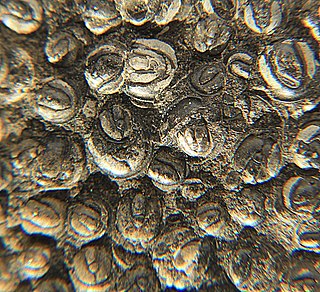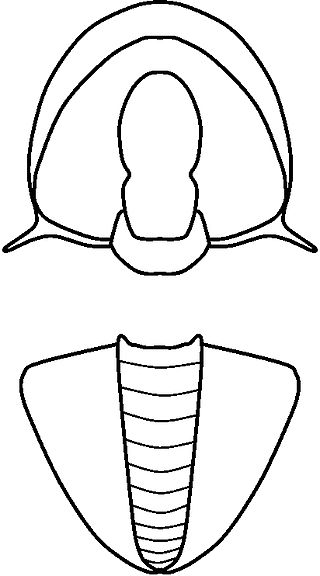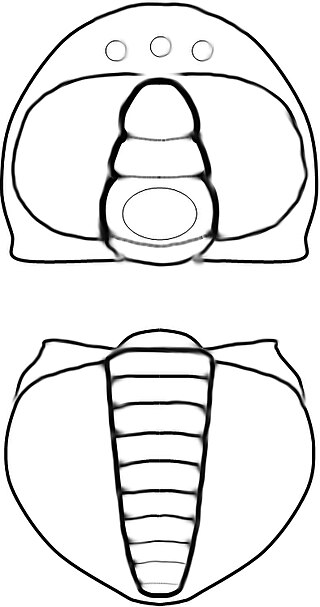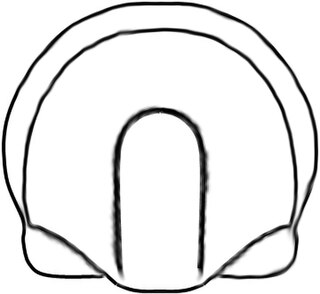
Agnostus is a genus of agnostid trilobites, belonging to the family Agnostidae, that lived during the late Middle Cambrian – early Upper Cambrian. It is the type genus of the family Agnostidae and is subdivided into two subgenera, Agnostus and Homagnostus.

Acidiscus Rasetti, 1966, is a genus of Eodiscinid trilobite belonging to the family Weymouthiidae Kobayashi T. (1943), Order Agnostida Salter (1864). It lived during the Botomian stage = late Lower Cambrian Stage 4 ; the upper Botomian boundary corresponds to base of the Middle Cambrian, Miaolingian Series and Wuliuan stage.

Acimetopus Rasetti, 1966, is a genus of Eodiscinid trilobite belonging to the family Weymouthiidae Kobayashi (1943), Order Agnostida Salter (1864). It lived during the Botomian stage. = late Lower Cambrian Stage 4 ; the upper Botomian boundary corresponds to base of the Middle Cambrian, Miaolingian Series and Wuliuan stage.

Analox Rasetti, 1966 is a genus of Eodiscinid trilobites belonging to the family Weymouthiidae Kobayashi T. (1943), Order Agnostida It lived during the Botomian stage. It can easily be distinguished from other trilobites by the two furrows that extend forwards and sidewards from the front of the glabella.

Ninadiscus Korobov, 1980, is a genus of Eodiscinid trilobite belonging to the family Weymouthiidae Kobayashi (1943), Order Agnostida Salter (1864). It lived during the Botomian Stage = late Lower Cambrian Stage 4 ; the upper Botomian boundary corresponds to the base of the Middle Cambrian, the Miaolingian Series and Wuliuan Stage.
Stigmadiscus Rasetti, 1966, is a genus of Lower Cambrian Eodiscinid trilobite belonging to the family Weymouthiidae Kobayashi (1943) Order Agnostida It lived during the Botomian stage, = late Lower Cambrian Stage 4 ; the upper Botomian Stage boundary corresponds to base of both the Middle Cambrian Wuliuan stage and Miaolingian Series.
Meniscuchus is an extinct genus from a well-known class of fossil marine arthropods, the trilobites. It lived during the Botomian stage, which lasted from approximately 522 to 516 million years ago. This faunal stage was part of the Cambrian Period. Meniscuchus has been found in the USA, Canada, Russia and Australia.

Tsunyidiscus is a trilobite belonging to the Suborder Eodiscina. Tsunyidiscus appeared near the end of the Lower Cambrian, during the late Atdabanian stage of geologic time and some collections suggest it may have survived into the Botomian. The genus is very small, oculate and isopypous with a narrow dome-shaped glabella and a narrow bullet-shaped pygidial axis. Thorax consists of three segments. Tsunyidiscus is the only genus currently attributed to the family Tsunyidiscidae.

Nephrolenellus is an extinct genus of trilobite, fossil marine arthropods, of relatively small size. Currently two species are attributed to it. Nephrolenellus lived at the end of the Lower Cambrian. Species are known from the Great Basin of California, Nevada and Arizona, with one specimen from Canada.
Acmarhachis is a genus of trilobite in the order Agnostida, which lived in what are now Australia, Canada, China (Anhui), Kazakhstan, Russia (Kharaulakh), and the US. It was described by Resser in 1938, and the type species is Acmarhachis typicalis.
Lotagnostus is a genus of very small trilobites in the order Agnostida, which lived on the outer continental shelves worldwide, during the late Upper Cambrian. It was described by Whitehouse in 1936, and the type species is Lotagnostus trisectus, which was originally described as a species of Agnostus by Salter in 1864.

Mallagnostus Howell, 1935, is a trilobite genus belonging to the family Weymouthiidae Kobayashi T. (1943), Order Agnostida Salter (1864) according to Whittington et al. 1997. It lived during the late Lower Cambrian, with remains found in USA, Canada (Newfoundland), Spain, England, Russia, Mongolia, and the early Middle Cambrian as reported from China and Russia (Yakutia).

Galbagnostus is an extinct genus of agnostid trilobite. It lived during the Lower and Middle Ordovician.

Delgadella is a diminutive trilobite that lived during the late Lower Cambrian and has been found in Russia, Mongolia, Spain, Italy (Sardinia), Portugal, Morocco and Canada (Newfoundland). It can be recognized by its strongly effaced headshield and tailshield, with narrow but distinct furrows and borders along its margins, and three thorax segments.

Pliomera is a genus of trilobites that lived during the Middle Ordovician on the paleocontinent Baltica, now Norway, Sweden, Estonia and the Russian Federation, and in Argentina. It can be recognized for its pentagonal glabella widest between the frontal corners, with an inverted V-shaped occipital ring. In front of the occipital furrow that crosses the entire glabella, two pairs of dead-ending furrows create three side lobes left and right. The front of the glabella also has three dead-ending furrows, a very short one on the midline and left and right a longer one, directed inward and slightly backward. The eyes are small and are not connected to the glabella by an eye ridge. The thorax and pygidium are very regularly divided into up to 23 rather narrow segments, without a furrow within each of the pleurae. The pleurae are clearly wider than the axis. The pygidium ends in downward pointing toothlike spines.
Tannudiscus Pokrovskaya (1959) is a genus of Eodiscinid trilobites belonging to the family Weymouthiidae Kobayashi T. (1943), Order Agnostida. It lived during the late Lower Cambrian, with remains found in Canada (Newfoundland), China (Gansu), The United Kingdom (England), and the Russian Federation.
The Hebediscidae Kobayashi, 1944, are a family of trilobites belonging to the order Agnostida that lived during the Lower Cambrian. They are small or very small, and have a thorax of two or three segments. The Hebediscidae include five genera.
The Calodiscidae Kobayashi, 1943 [nom. transl. Öpik, 1975 ex Calodiscinae Kobayashi, 1943] are a family of trilobites belonging to the order Agnostida that lived during the Lower Cambrian. They are small or very small, and have a thorax of two or three segments. The Calodiscidae includes five genera.

Jinghediscus Xiang & Zhang, 1985 is a genus of Eodiscinid trilobite belonging to the family Weymouthiidae Kobayashi T. (1943), Order Agnostida It lived during the lower Middle Cambrian, with remains found in China (Xinjiang) and Australia (Queensland).

Tricrepicephalus is an extinct genus of ptychopariid trilobites of the family Tricrepicephalidae with species of average size. Its species lived from 501 to 490 million years ago during the Dresbachian faunal stage of the late Cambrian Period. Fossils of Tricrepicephalus are widespread in Late Cambrian deposits in North America, but is also known from one location in South-America. Tricrepicephalus has an inverted egg-shaped exoskeleton, with three characteristic pits in the fold that parallels the margin of the headshield just in front of the central raised area. The articulating middle part of the body has 12 segments and the tailshield carries two long, tubular, curved pygidial spines that are reminiscent of earwig's pincers that rise backwards from the plain of the body at approximately 30°.













